Kashmir, and the inheritance of loss
About 50 people have been killed and 3,100 injured, nearly half of them Indian troops but also children as young as 4
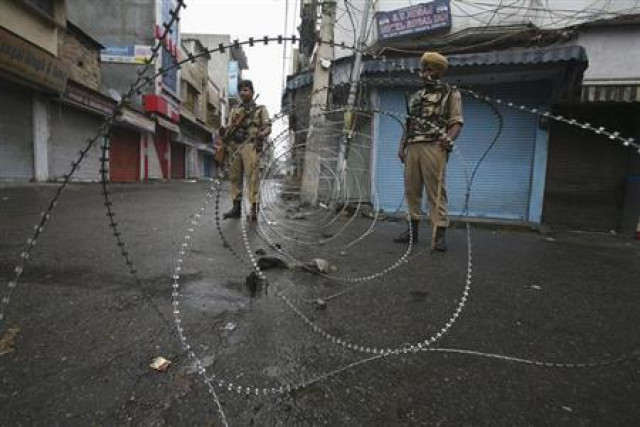
Policemen stand guard at a street during a curfew following riots, in Indian-held Kashmir. PHOTO: REUTERS
He had become an Internet sensation over the past year, first in Kashmir, then in India and Pakistan, after putting together a small band of Kashmiri militants. Barely out of their teens, they had taken to the forest and social media to challenge the Indian government. Photos they posted on Facebook show them in military fatigues and with stubbly chins, posing with AK-47s against backdrops of apple orchards or mountains. In one video, Burhan plays cricket.
Kashmir crisis: APHC local chapter kept out of the loop
A dozen boys with a few guns — they were no threat to the Indian army, one of the largest in the world. There is no record of Burhan and his crew waging any attack. Their rebellion was symbolic, a war of images against India’s continuing occupation of Kashmir, where about half a million of its soldiers, paramilitary and armed police are still stationed.
According to top police officials, Burhan and two other militants were killed on the evening of July 8 in a gun battle that broke out after Indian soldiers and Kashmiri police surrounded the house in which they had sought shelter.
Protests erupted on the day of Burhan’s funeral and were repressed by Indian troops with indiscriminate force, including pellet guns: As of Monday, about 50 people had been killed and 3,100 injured, nearly half of them Indian troops but also children as young as 4. Instead of opening political negotiations to address Kashmiris’ calls for independence, India continues to unabashedly use military force to maintain a status quo that for years has suffocated millions in the region.
When I first saw the photos of Burhan and his boys, I thought: another generation of young Kashmiris about to be consumed. Those apple orchards and mountains in the background, which I know intimately and call home, brought back memories of the early ’90s, when I was a teenager in southern Kashmir. An armed insurgency supported by Pakistan and a popular rebellion were underway then, triggered by the Indian government’s meddling in a recent state election.
Eight killed in Indian-held Kashmir after rebel leader’s death
By the time the insurgency was quashed in the late 2000s, more than 70,000 militants, soldiers and civilians had been killed. Still, hundreds of thousands of Kashmiris would occasionally take to the streets. Indian troops continued to respond with violence, even against civilians armed with nothing or nothing more than stones. Hardly any soldier has been prosecuted for civilian killings because Indian law has long granted immunity to troops posted in Indian-held Kashmir and other troubled regions. (A recent decision by India’s Supreme Court may change this.)
Burhan came of age with this inheritance of loss and rage. He was 15, a top-ranking student from a middle-class family, in 2010 — that summer alone Indian forces killed more than 110 Kashmiri protesters. One afternoon that year, Indian police officers posted in Burhan’s town reportedly sent him and his brother Khalid to fetch cigarettes and then beat up the boys when they returned. Humiliated, Burhan left for the mountains and joined a tiny group of militants. Then last year, Khalid, who was doing post-graduate work in economics, was killed by Indian soldiers.
On the morning of July 9, Burhan’s body was brought to a vast open ground in Tral, his hometown, about 25 miles east of Srinagar. In the early hours, the photojournalist Javed Dar saw that hundreds of people who had come from nearby villages were sleeping on the streets, some using rocks as pillows. About 200,000 people are reported to have attended the funeral throughout the day. Prayers were repeated several times to accommodate newcomers. A slogan I had heard at numerous funerals in the 90s roared up from the valley again: “Burhan, tere khoon se, inquilab aayega,” “Burhan, your blood will bring forth the revolution!”
As Indian-held Kashmiris seethed with desperate anger that day, Indian paramilitaries and police were deployed across the region. In hundreds of locations, people came out to mourn Burhan and raise their voices against the Indian occupation. The vast majority were unarmed. In some places, protesters picked up stones and charged at camps of Indian soldiers and police.
The troops responded with a brutality rare even by the grim standards of their record in Indian-held Kashmir. They fired bullets, tear gas and lead pellets. Soon, the Indian government imposed a military curfew.
I reached Indian-held Kashmir from Delhi on July 11, and the next morning when I woke up in my parents’ house in southern Srinagar, I heard only crickets chirping in the backyard. The streets were desolate except for groups of Indian paramilitary troops with guns and bamboo sticks. The pro-India politicians who run the Indian-held Kashmir government had all but disappeared from public view.
Kashmiris, as they do in crisis, turned to themselves for support. At Shri Maharaja Hari Singh (SMHS) Hospital in central Srinagar, where the injured had been brought by the hundreds, scores of volunteers were offering medicine, money, clothes and care to the patients and their families. On one wall in the lobby hung a banner with the words, “The Martyrs Ask of You: Remember Us,” and two photographs of Burhan. One showed him standing against a mountainous backdrop; the other was of his bullet-ridden corpse on a stretcher.
I walked into an ophthalmology ward. There were about 20 beds with a teenager or young man in each and relatives standing around in anxious huddles. Almost every patient had large, black sunglasses. “Seventy-two patients with pellet injuries arrived here in one day,” one doctor told me. As of Sunday, SMHS Hospital alone had received more than 180 people with serious wounds to the eyes.
Pakistan condemns India's killing of Hizbul Mujahideen commander in occupied Kashmir
A single shot from a pellet gun sprays more than a hundred pellets. A pellet is a high-velocity projectile 2mm to 4mm around and with sharp edges. It doesn’t simply penetrate an eye; it ricochets inside it, tearing the retina and the optic nerves, scooping out flesh and bone.
I walked through the hospital with Dr. Javed Shafi, a surgeon in his early 40s, as he was making bed calls with his patients.
The day before he had operated on Shafia Jan, a pale, slim woman in her mid-20s from Arwani, a village about 50 miles south. She had stepped out of her house after hearing commotion on the street during protests following Burhan’s death, she explained. A police officer fired his pump-action gun toward her.
“I didn’t feel anything at first. Then, my left leg crumbled and I fell. I saw my intestines falling out,” Ms. Jan told me. She pushed her guts back into the wound and held them in with her hands. Scores of pellets had pierced her lower abdomen, opening up the scars of an earlier C-section.
Omar Nazir, a reed-thin boy of 12, barely filled one corner of his bed. A thick swathe of bandages formed a cross across his chest and belly. He had black, adult-size glasses. “He’s lost both his eyes,” Dr. Shafi said. Doctors had yet to deliver the news to Nazir Ahmad, the boy’s father, a day laborer in Pulwama, a district in southern Indian-held Kashmir, but he already seemed to know. Mr. Ahmad, tall and wiry, looked at the doctor, his eyes liquid with entreaty: “Dr. Sahib, we own one-fifth of an acre of land in the village. I will sell all my land, but please make him see.”
In other corners of the hospital: A young man with the face of Adrian Brody whose penis had to be amputated because it had been shredded by pellets. A four-year-old girl, her legs and abdomen riddled by what she called “firecrackers.” And Insha Malik.
I had read about Insha, 14, in that morning’s paper. The photograph accompanying the article showed a face with red wart-like wounds. Her nasal bridge was a lump of raw flesh held together by black surgical thread. The bloodied lids of her left eye had been sown shut. Her right eye was a red alloy of blood, flesh, bone and metal.
Insha was in the surgical intensive care unit of SMHS Hospital, a few rooms away from the ward I visited with Dr. Shafi. Afroza Malik, her mother, a woman in her early 50s, sat right by the I.C.U. door on the bare floor. Her husband, who had a leg injury from an earlier accident, was lying on a blanket, his head in his wife’s lap. She was stroking his graying hair.
Ms. Malik explained that on July 12, she, Insha and several relatives had taken refuge in an upstairs room of their two-story house in Sedew, a tiny village 40 miles south of Srinagar. They closed the thick wooden windows and sat on the floor. They heard tear gas canisters being fired; they heard gunshots. A loud noise followed. A pellet gun had been fired at the window. Insha was sitting nearby. “The window was blown to pieces,” Ms. Malik told me. “I heard her wail and saw blood flowing out of her eyes. She fell on the floor.”
A few days later, the police raided the offices of Greater Kashmir, the daily that had run that story about Insha, as well as several other local newspapers, and shut down the printing presses. The authorities’ familiar silencing routine had begun again. Indian officials and thought leaders fell back on tired rituals of obfuscation and denial. But already one line of graffiti had appeared on every other wall throughout the entire valley: “Go India, Go Back!”

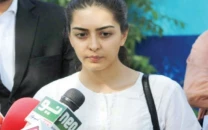


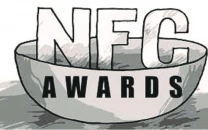
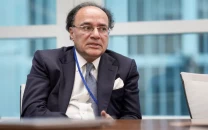
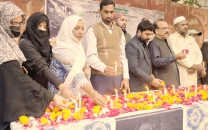












COMMENTS
Comments are moderated and generally will be posted if they are on-topic and not abusive.
For more information, please see our Comments FAQ